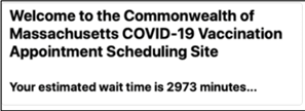A Blog About Understanding The Toyota Production System and Gaining Its Full Benefits, brought to you by "The Toast Guy"

You’re My #1 Customer

I sat on the phone on hold this morning, serenaded by Christmas music, interrupted periodically by a recorded message, “Your call is very important to us . . . “ As I waited, I mused on that scene from the Christmas classic, “Jingle All The Way,” where Howard Langdon (Arnold Schwarzenegger) frantically tries to power through the queue of waiting customers. At the end of each call, he reflexively concludes with the expression “You’re my number 1 customer.” The scene makes me chuckle because I’ve been on both ends of that queue many times. I do believe that most of us really want every one of our customers to feel like #1, just as we would like to feel that way when we are on the receiving end. We want perfect quality and zero hassles; and in the information age, we order today because we want it today.
Alas, while most organizations aspire to create that level of customer experience, their systems and policies make it very difficult. Like factory inventory, customers must be placed in queues when they cannot be served immediately. Lines at supermarkets, traffic jams, waiting rooms, and, yes, phone queues. The invention in 1989 (not so long ago) of the auto-attendant was intended to improve efficiency by automatically directing calls; a job that older folks like me will recall was once done by a person. Where the desk of receptionist once stood, there is now just a phone with a sign above it: “If you know your party’s extension, please dial it now.”
If you are calling from outside there are further enhancements to improve the waiting experience:
- A clarifying greeting. (“Please listen carefully to the following options, as our menu has recently changed.”)
- An explanation. (“All representatives are busy serving other customers.” Or, “ Due to high call volumes. . . .”)
- An apology. (“We’re sorry. Someone will be with you shortly.”)
- Music. (Who chooses that? Improvement idea: Give the caller the option to choose.)
- A marketing pitch. (“Rated #1 in service by . . . .” )
- A message to let you know where you are in the queue. (“There are 14 callers ahead of you.”)
- An offer to call you back. (“Dial 1 if you’d like us to call you back . . .” )
- Or the old standard. (“Please leave a message . . . )

An advanced auto-attendant may, in fact, intermix all of these responses – or you may be encouraged to use an app (“For faster service please contact us at www. . . .”) Of course, the nano-second capabilities of the Internet do not guarantee an immediate response. Here’s a screen capture of an online inquiry I made in February 2021 🙂
Shigeo Shingo referred to these enhancements as “superficial improvements” because they automate the waste of waiting rather than eliminating it. All of the embellishments exist only because the connection is not available. Ultimately, if the proper party does not pick up, as Eli Goldratt might have noted, we have just moved the bottleneck.
The original auto-attendant concept was intended to improve the flow of the customer’s inquiry by quickly directing it to the proper party. If we were to consider only the operational time, that might be true. But, for a customer faced with a nested process of choices based on 10 phone digits, there are plenty of opportunities for mistakes, rework, and frustration. For me, there is nothing more surprisingly delightful than to reach a real person like Howard Langdon immediately. But I will confess, if you try to reach me by phone, you may hear: “That mailbox is full.” (A little 5S problem.)
In any event, have a Merry Christmas and remember: YOU’RE MY #1 CUSTOMER. 🙂
O.L.D.
Looking for a last minute gift for the passionate Lean practitioner in your life? Look no further than ShopGBMP and our annual Holiday Sale!
